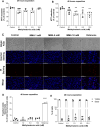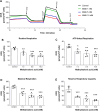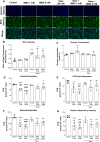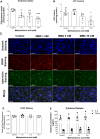Methylmalonic Acid Impairs Cell Respiration and Glutamate Uptake in C6 Rat Glioma Cells: Implications for Methylmalonic Acidemia
- PMID: 35674974
- PMCID: PMC11414442
- DOI: 10.1007/s10571-022-01236-1
Methylmalonic Acid Impairs Cell Respiration and Glutamate Uptake in C6 Rat Glioma Cells: Implications for Methylmalonic Acidemia
Abstract
Methylmalonic acidemia is an organic acidemia caused by deficient activity of L-methylmalonyl-CoA mutase or its cofactor cyanocobalamin and it is biochemically characterized by an accumulation of methylmalonic acid (MMA) in tissue and body fluids of patients. The main clinical manifestations of this disease are neurological and observable symptoms during metabolic decompensation are encephalopathy, cerebral atrophy, coma, and seizures, which commonly appear in newborns. This study aimed to investigate the toxic effects of MMA in a glial cell line presenting astrocytic features. Astroglial C6 cells were exposed to MMA (0.1-10 mM) for 24 or 48 h and cell metabolic viability, glucose consumption, and oxygen consumption rate, as well as glutamate uptake and ATP content were analyzed. The possible preventive effects of bezafibrate were also evaluated. MMA significantly reduced cell metabolic viability after 48-h period and increased glucose consumption during the same period of incubation. Regarding the energy homeostasis, MMA significantly reduced respiratory parameters of cells after 48-h exposure, indicating that cell metabolism is compromised at resting and reserve capacity state, which might influence the cell capacity to meet energetic demands. Glutamate uptake and ATP content were also compromised after exposure to MMA, which can be influenced energy metabolism impairment, affecting the functionality of the astroglial cells. Our findings suggest that these effects could be involved in the pathophysiology of neurological dysfunction of this disease. Methylmalonic acid compromises mitochondrial functioning leading to reduced ATP production and reduces glutamate uptake by C6 astroglial cells.
Keywords: Cell dysfunction; Energy metabolism; Glutamate uptake; High-resolution respirometry; Methylmalonic academia; Organic acidemias.
© 2022. The Author(s), under exclusive licence to Springer Science+Business Media, LLC, part of Springer Nature.
Conflict of interest statement
The authors declare no conflict of interests.
Figures






Similar articles
-
Methylmalonic Acid Compromises Respiration and Reduces the Expression of Differentiation Markers of SH-SY5Y Human Neuroblastoma Cells.ACS Chem Neurosci. 2021 Jul 21;12(14):2608-2618. doi: 10.1021/acschemneuro.1c00119. Epub 2021 Jun 30. ACS Chem Neurosci. 2021. PMID: 34191487
-
Biochemical and anaplerotic applications of in vitro models of propionic acidemia and methylmalonic acidemia using patient-derived primary hepatocytes.Mol Genet Metab. 2020 Jul;130(3):183-196. doi: 10.1016/j.ymgme.2020.05.003. Epub 2020 May 11. Mol Genet Metab. 2020. PMID: 32451238 Free PMC article.
-
Methylmalonic acid induces inflammatory response and redox homeostasis disruption in C6 astroglial cells: potential glioprotective roles of melatonin and resveratrol.Amino Acids. 2022 Nov;54(11):1505-1517. doi: 10.1007/s00726-022-03191-z. Epub 2022 Aug 4. Amino Acids. 2022. PMID: 35927507
-
New insights into the pathophysiology of methylmalonic acidemia.J Inherit Metab Dis. 2023 May;46(3):436-449. doi: 10.1002/jimd.12617. J Inherit Metab Dis. 2023. PMID: 37078237 Free PMC article. Review.
-
Neurological dysfunction in methylmalonic acidaemia is probably related to the inhibitory effect of methylmalonate on brain energy production.J Inherit Metab Dis. 1997 Nov;20(6):761-8. doi: 10.1023/a:1005359416197. J Inherit Metab Dis. 1997. PMID: 9427143 Review.
Cited by
-
Serum methylmalonic acid concentrations at breast cancer diagnosis significantly correlate with clinical frailty.Geroscience. 2024 Apr;46(2):1489-1498. doi: 10.1007/s11357-023-00908-0. Epub 2023 Aug 26. Geroscience. 2024. PMID: 37632634 Free PMC article.
-
Brain and behavioural anomalies caused by Tbx1 haploinsufficiency are corrected by vitamin B12.Life Sci Alliance. 2024 Nov 20;8(2):e202403075. doi: 10.26508/lsa.202403075. Print 2025 Feb. Life Sci Alliance. 2024. PMID: 39567195 Free PMC article.
-
The first evidence of biological activity for free Hypusine, an enigmatic amino acid discovered in the '70s.Amino Acids. 2023 Jul;55(7):913-929. doi: 10.1007/s00726-023-03283-4. Epub 2023 May 31. Amino Acids. 2023. PMID: 37258638
References
-
- Abbott NJ, Ronnback L, Hansson E (2006) Astrocyte-endothelial interactions at the blood-brain barrier. Nat Rev Neurosci 7(1):41–53. 10.1038/nrn1824 - PubMed
-
- Baumgartner MR, Horster F, Dionisi-Vici C, Haliloglu G, Karall D, Chapman KA, Huemer M, Hochuli M, Assoun M, Ballhausen D, Burlina A, Fowler B, Grunert SC, Grunewald S, Honzik T, Merinero B, Perez-Cerda C, Scholl-Burgi S, Skovby F, Wijburg F, MacDonald A, Martinelli D, Sass JO, Valayannopoulos V, Chakrapani A (2014) Proposed guidelines for the diagnosis and management of methylmalonic and propionic acidemia. Orphanet J Rare Dis 9:130. 10.1186/s13023-014-0130-8 - PMC - PubMed
-
- Bradford MM (1976) A rapid and sensitive method for the quantitation of microgram quantities of protein utilizing the principle of protein-dye binding. Anal Biochem 72:248–254. 10.1006/abio.1976.9999 - PubMed
MeSH terms
Substances
Supplementary concepts
Grants and funding
LinkOut - more resources
Full Text Sources

